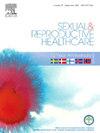Expectant and new mothers’ experiences from digital midwifery care and information during pregnancy and postpartum
IF 1.7
3区 医学
Q3 PUBLIC, ENVIRONMENTAL & OCCUPATIONAL HEALTH
引用次数: 0
Abstract
Objective
Globally, the use of digital solutions in midwifery care, parental information, and antenatal classes is increasing. However, research on how these digital solutions function for mothers has not kept pace. Therefore, the aim of this study was to describe expectant and new mothers’ experiences from digital midwifery care and information during pregnancy and postpartum.
Methods
This is a Swedish study with a qualitative method and an inductive approach. Twelve expectant and new mothers were individually interviewed, and data was analysed using thematic analysis.
Results
The results are presented in one overall theme: An ongoing Negotiation between digital and physical midwifery care is required to promote engagement and address needs, and three themes: A complement that creates flexibility but request balance; Enable participation and inclusion of partners, and The needs of being seen and heard are met to various extends.
Conclusion
While the flexibility offered through digital midwifery care and parental information is beneficial and facilitates convenience for mothers, digital midwifery care is not entirely interchangeable with physical midwifery care, including antenatal classes. An ongoing negotiation between digital and physical midwifery care is essential to achieve balanced midwifery care that addresses the unique, individual needs of mothers throughout different stages during pregnancy and postpartum.
孕妇和新妈妈在孕期和产后的数字助产护理和信息体验
在全球范围内,助产护理、父母信息和产前课程中数字解决方案的使用正在增加。然而,关于这些数字解决方案如何对母亲起作用的研究却没有跟上步伐。因此,本研究的目的是描述孕妇和新妈妈在怀孕和产后的数字助产护理和信息的体验。方法采用定性和归纳相结合的研究方法。对12位准妈妈和新妈妈进行了单独访谈,并使用主题分析对数据进行了分析。结果结果呈现在一个总体主题中:需要在数字和物理助产护理之间进行持续的谈判,以促进参与和满足需求;三个主题:创造灵活性但要求平衡的补充;促进合作伙伴的参与和包容,并在不同程度上满足被看到和听到的需求。结论虽然数字助产护理和家长信息提供的灵活性是有益的,并为母亲提供了便利,但数字助产护理与物理助产护理(包括产前课程)并不完全可互换。数字助产护理和物理助产护理之间的持续谈判对于实现平衡的助产护理至关重要,以满足母亲在怀孕和产后不同阶段的独特个性化需求。
本文章由计算机程序翻译,如有差异,请以英文原文为准。
求助全文
约1分钟内获得全文
求助全文
来源期刊

Sexual & Reproductive Healthcare
PUBLIC, ENVIRONMENTAL & OCCUPATIONAL HEALTH-
CiteScore
2.70
自引率
5.60%
发文量
73
审稿时长
45 days
 求助内容:
求助内容: 应助结果提醒方式:
应助结果提醒方式:


